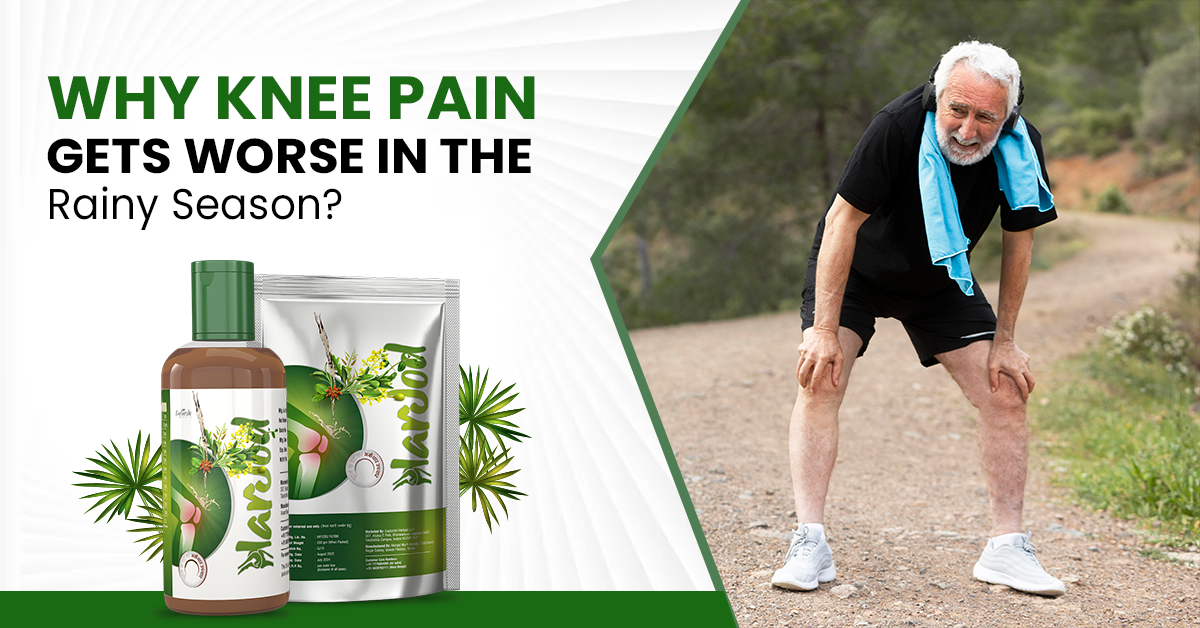Have you noticed that your knee pain becomes worse just before or during the rainy season? Many individuals complain of joint issues like stiffness, swelling, and discomfort during monsoons. Why does this typically happen during this season of the year? And what does Ayurveda, the oldest science of healing, have to say about it?
This article shares the real reasons behind monsoon-related joint and knee pain and what you can do to get relief, naturally.
Why does knee pain trigger during the rainy season?
A major change in the atmosphere happens during the rainy season. The air has moisture with increased humidity, sunlight is reduced, and there is a drop in temperature. While monsoon is a great escape from summer heat, it also brings discomfort to your knees and other joints.
The drop in temperature with less sunlight slows down the digestion and circulation. For those with knee arthritis or joint pain, this weather affects the body more than anyone else.
What Does Ayurveda Say?
According to Ayurveda, the rainy season is the time when Vata dosha — the energy of air and space — gets aggravated. Vata governs movement, flexibility, and circulation in the body. When Vata becomes unbalanced, you feel dryness in the joints, stiffness, and pain. Sometimes there is cracking or clicking in the knees.
The body accumulates ama in the body due to bad digestion and slowed-down metabolism during the rainy season. This worsens the joint pain, especially in those who are suffering from sandhivata (osteoarthritis) are at the receiving end during this season.
Why Knee Pain Gets Worse in Monsoon?
Let’s figure out and break it down in simple terms:
1. Low Atmospheric Pressure
When it rains, the pressure in the air drops. This causes the tissues in your joints to expand slightly, which puts more pressure on the nerves in your knee, resulting in more pain. Though not scientifically proven, people with their experience vouch for this.
2. Cold and Damp Weather
Cool temperatures cause muscles to stiffen. Add moisture to the mix, and it creates a damp environment in your body, creating a Vata imbalance.
Ayurveda says: “Sheeta (cold) and Snigdha (wet) trigger Vata in asthi (bones)”
3. Toxin Build-Up (Ama)
The rainy season slows digestion, which leads to undigested food turning into ama ( toxins). These toxins travel to the joints, like the knee joints, and settle there, leading to inflammation. The more the toxins build up, the more pain and swelling.
4. Reduced Sunlight, Poor Circulation
Less sunlight means reduced body’s ability to make vitamin D, weakening the bones and joints. Blood circulation also drops in cold weather, depriving the joints of enough nutrients. Weaker circulation leads to joint weakness and a slower ability to heal.
Ayurvedic Way to Manage Knee Pain in the Rainy Season
You don’t have to suffer for the whole season. The rainy season can be enjoyed if you follow these Ayurvedic practices. They are the natural ways to calm down your joints during monsoon:
1. Oil Massages or Abhyanga
Massaging the body with warm oil is a crucial part of ayurvedic healing. Massaging the knees with herbal oil improves the blood circulation in the joints and reduces stiffness, balancing Vata and improving flexibility.
- Mahanarayan Oil
- Nirgundi Oil
- Damdar Oil (for deep, fast relief)
- Dhanwantharam Thailam
2. Keep the Joints Warm and Covered
Sitting on cold floors is a big no-no. Keep your knees covered at night and protect the joints from moisture.
3. Eat Vata-Pacifying Foods
Eat warm, moist, and easily digestible meals like khichdi with ghee, cooked vegetables, and herbal teas. Spice up your food with ginger, garlic, and turmeric.
Avoiding raw vegetables, cold, fried, and stale foods, and curd at night is best recommended in Ayurveda.
A healthy gut means fewer toxins, resulting in less pain.
4. Use Herbal Remedies for Relief
You can take ayurvedic herbs that reduce inflammation and strengthen joints, like Ashwagandha, Guggulu, Shallaki (Boswellia), turmeric, and Rasna.
These herbs help clear toxins, reduce swelling, and calm aggravated Vata.
Harjod Knee Pain Relief Therapy
Harjod is an ayurvedic knee pain relief therapy, which includes Harjod pain relief oil, Harjod Arkdhara, and capsules that are formulated using proven herbs that have anti-inflammatory, analgesic, and detoxifying properties. Herbs like Rasot, Nirgundi, Arand, and other herbs contribute to the formulation of this ayurvedic knee pain relief therapy.
The Arkdhara paddhati is followed in this therapy to provide deeper penetration of oil into the knee joints, soothing them and relieving pain.
5. Tender Movement is Better than No Movement
Don’t stop moving. Gentle stretches and light walks improve circulation and prevent stiffness. Practice yoga poses like leg raises, pranayama, tadasana, and vajrasana.
Final Thoughts
The rainy season is beautiful, but it can make your knee pain worse. Don’t let the rain rule you or your knees. Instead of opting for painkillers, try ayurvedic ways to keep your joints pain-free and mobile. Keep your joints warm, eat light and healing foods, and massage daily with herbal oils. You can try knee pain relief therapy such as Harjod.
This monsoon, let ayurvedic knee pain relief therapy be your umbrella against pain.






